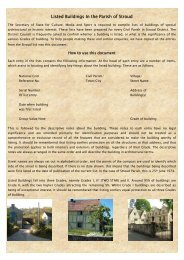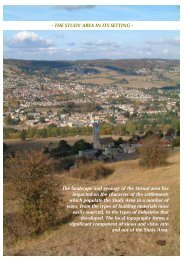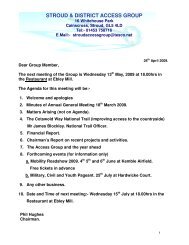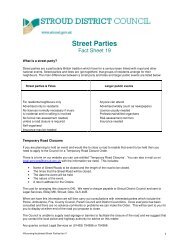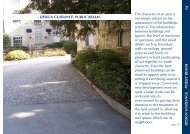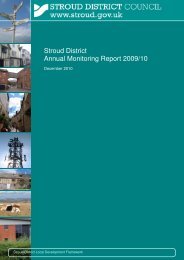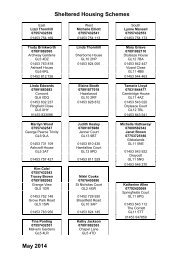conservation area statement - Stroud District Council
conservation area statement - Stroud District Council
conservation area statement - Stroud District Council
Create successful ePaper yourself
Turn your PDF publications into a flip-book with our unique Google optimized e-Paper software.
CONSERVATION AREA STATEMENT – CONSERVATION AREA NO. 16 – TOP OF TOWNHISTORY TOP OF TOWNORIGINS OF THE SETTLEMENTAlthough <strong>Stroud</strong> parish was originally part ofBisley, its identity as a distinct unit had begunto emerge by the 13 th century.The manor houses of Paganhill, Over Lypiattand Nether Lypiatt formed the most ancientdwelling places within what was to becomethe <strong>Stroud</strong> parish, but the parish would take itsname from a tiny <strong>area</strong> called ‘la strode’, whichwas first recorded in 1221.The settlement however, seems to haveoriginated a little further up the hill, the earliesthouses being built on the better-drained slopeat the end of the ridge which lies between thetwo streams. The origins of the settlement arerooted in Gloucestershire’s medieval wooltrade, the occupations of spinning and weavingbeing an ever-evolving tradition, whichcontinued to influence <strong>Stroud</strong>’s developmentinto the 20 th century.The early expansion of the settlement, centredaround what is now known as High Street, onthe route between Bisley and Paganhill. Thechurch was built by 1279 and was sited northof High Street. However it was not until 1304that it was assigned parochial rights by therectors of Bisley. The parochial rights made thetiny church the ecclesiastical centre of theparish. The West Tower of the church, datingfrom the 14 th century, still forms part of StLaurence’s today.EXPANSION AND DEVELOPMENT OFSTROUDSixteenth CenturyThe development of the town from the 16 thcentury was fairly rapid, centring on a tradingspace, around an <strong>area</strong> between the 13 th centurychurch and what we now know as High Street.Around 1590, a Market House was built hereby John Throckmorton, lord of Over LypiattManor. Now known as the Town Hall, muchof it survives, with some 19 th century additionsand alterations. The building was originallyfreestanding in the centre of an open square,the market <strong>area</strong>, which was known in the 17 thcentury as ‘the Pitching’, but later became ‘TheShambles’. Trading and other activities alsotook place at The Cross.Seventeenth CenturyBy the early 17 th century, the town had both amarket and fair, and by 1654 the principal innof the town, The George, had opened on thesouth side of the High Street.The development of <strong>Stroud</strong> owes much to thecloth industry, which can be traced back to atleast the 14 th century in the <strong>Stroud</strong> Valley.Gloucestershire had a thriving wool trade, andthe Cotswolds had been used for sheepfarming since ancient times, the quality ofwool produced in the region was renowned. Itwas this industrial and mercantile basis, ratherthan a strictly agrarian one, which was to playthe major role in the town’s expansion andchanging fortunes. By the early 17 th century,textile production was the dominant industrywithin the <strong>area</strong>. <strong>Stroud</strong> town became known asthe centre of this industry, supporting the clothproductionof the surrounding valleys, andbeing described in the mid 18 th century as “asort of capital of the clothing villages’.There are examples of the mid-to late- 17 thcentury mostly within the streets up the hillbeyond the Cross, evidence of the eastwardexpansion which occurred over the 17 th and18 th centuries.It is mainly on Lower Street, Middle Street andWhitehall that surviving houses of the 17 th orearly 18 th century can be seen today. The <strong>area</strong>was developed as a weaving suburb betweenc.1680 and 1720, and its heritage as such canbe detected in the built form of the cottages.Eighteenth CenturyThe focus of the town was still very muchtoward the north and east of High Street duringthe 1700s.In June 1742, the Shambles was the site of asermon preached by John Wesley. During themid 18 th century, a strong Methodist followingPage 6



